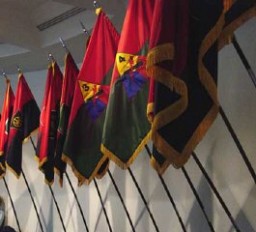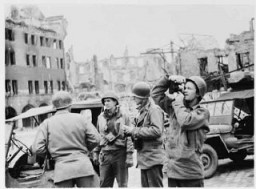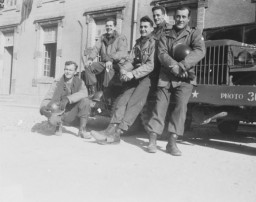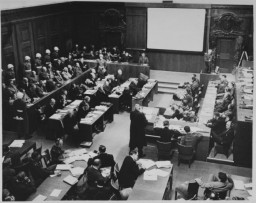
The United States Army Signal Corps
The Signal Corps, a longstanding part of the US Army expanded greatly during WWII. They had a crucial role in documenting the atrocities perpetrated during the Holocaust.
Beginnings of the Signal Corps
The US Army Signal Corps began in 1860, with the appointment of Dr. Albert J. Myer, a physician, as Chief Signal Officer. Under his command, the unit transformed sign language used to communicate with deaf persons into a semaphore system incorporating red and white “wigwag” flags. During the Civil War, the Signal Corps operated air balloons and telegraph machines. By the time the United States entered World War I in 1917, the corps had integrated the airplane and more advanced technology into its communications systems.
During World War II
In World War II, the Signal Corps' size and role in military affairs increased dramatically. From a staff of 27,000 persons, it expanded to over 350,000 men and women by 1945. The need to coordinate swift and accurate communication for air, ground, and naval units required more sophisticated technology and services. The Signal Corps pioneered in the development of radar to detect approaching aircraft as well as mobile communications and deciphering machines.
In addition to its primary role in military transmissions, the unit also played a key role in producing training films for army and civilian personnel, and documenting combat missions. During World War II, noted Hollywood producers, directors, and photographers (such as Darryl Zanuck, Frank Capra, John Huston, and George Stevens) all served in the Signal Corps. They brought their talents in the motion picture studio to the field of battle, while dozens of others provided instruction to the personnel.
In the European theater of operations (ETO), Signal Corps photographers took part in the landings in North Africa, Italy, and later Normandy. On D-Day (June 6, 1944), members of the unit hit the Utah and Omaha beaches, forwarding the first film of the amphibious assaults to England via carrier pigeons. The Signal Corps subsequently documented every major military campaign in the ETO, producing millions of feet of combat film and hundreds of thousands of developed still images. From these sources, the Army supplied the news media in the United States and elsewhere with imagery of the war, using 24-hour air delivery service and later sophisticated telephoto electronic-transmission equipment.
In the course of photographing World War II, the Signal Corps also played a crucial role in documenting evidence of Nazi atrocities and the Holocaust. Many of the early still and moving pictures of newly liberated Nazi concentration camps were taken by Army photographers such as Arnold E. Samuelson and J Malan Heslop. A number of these images were later transmitted to news agencies in America and other countries, where they helped to inform the world about the horrors of Nazism and the plight of concentration camp prisoners. The US Army and the Allied military governments of Germany eventually used these photographs to confront German prisoners of war in the United States and the German population with the evidence of Nazi crimes.
Series: Liberation of Nazi Camps: Encountering and Documenting Atrocities
Critical Thinking Questions
- Consider the importance of primary sources such as photographs. What can we learn from them?
- Why do military forces document their actions?
- Learn about documentation of genocide and mass atrocities since the Holocaust. How has this evidence been used, if at all?
- Research the use of photographs during the war and after, for documentation, propaganda, education, and memorialization.
Further Reading
Jones, Marla, “Photographers document wartime Army,” Army Communicator, Special Edition: The Signal Corps in World War II, vol. 20, no. 4.
Rodgers, Mike “Signal Corps photographers capture D-day,” Army Communicator, Special Edition: The Signal Corps in World War II, vol. 20, no. 4.
Terret, Dulany, “The Signal Corps: the emergency (to December 1941)”. Washington, Office of the Chief of Military History, US Army, 1956.
Thompson, George Raynor, “The Signal Corps: the outcome (mid-1943 through 1945)”. Washington, Office of the Chief of Military History, US Army, 1966.
Thompson, George Raynor, "Overview: the Signal Corps in World War II," Army Communicator, Special Edition: The Signal Corps in World War II, vol. 20, no. 4.





